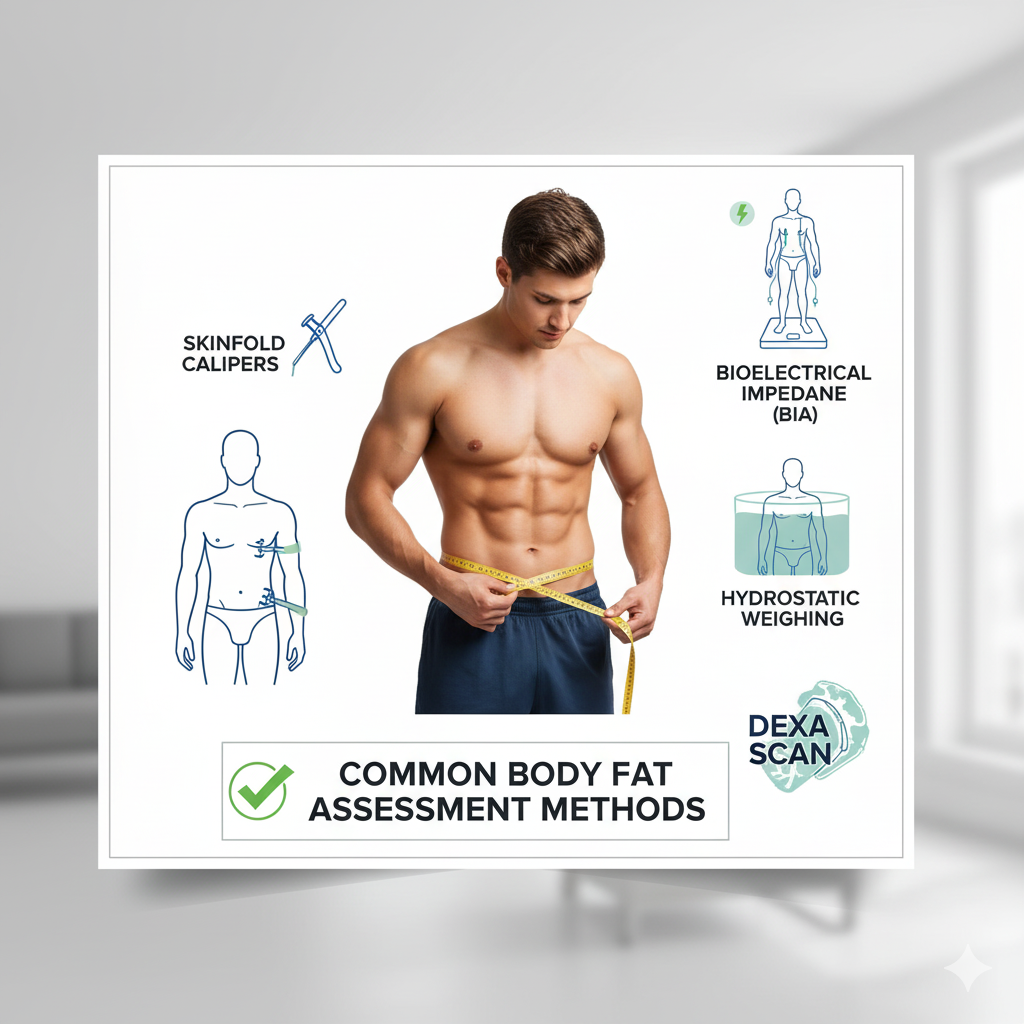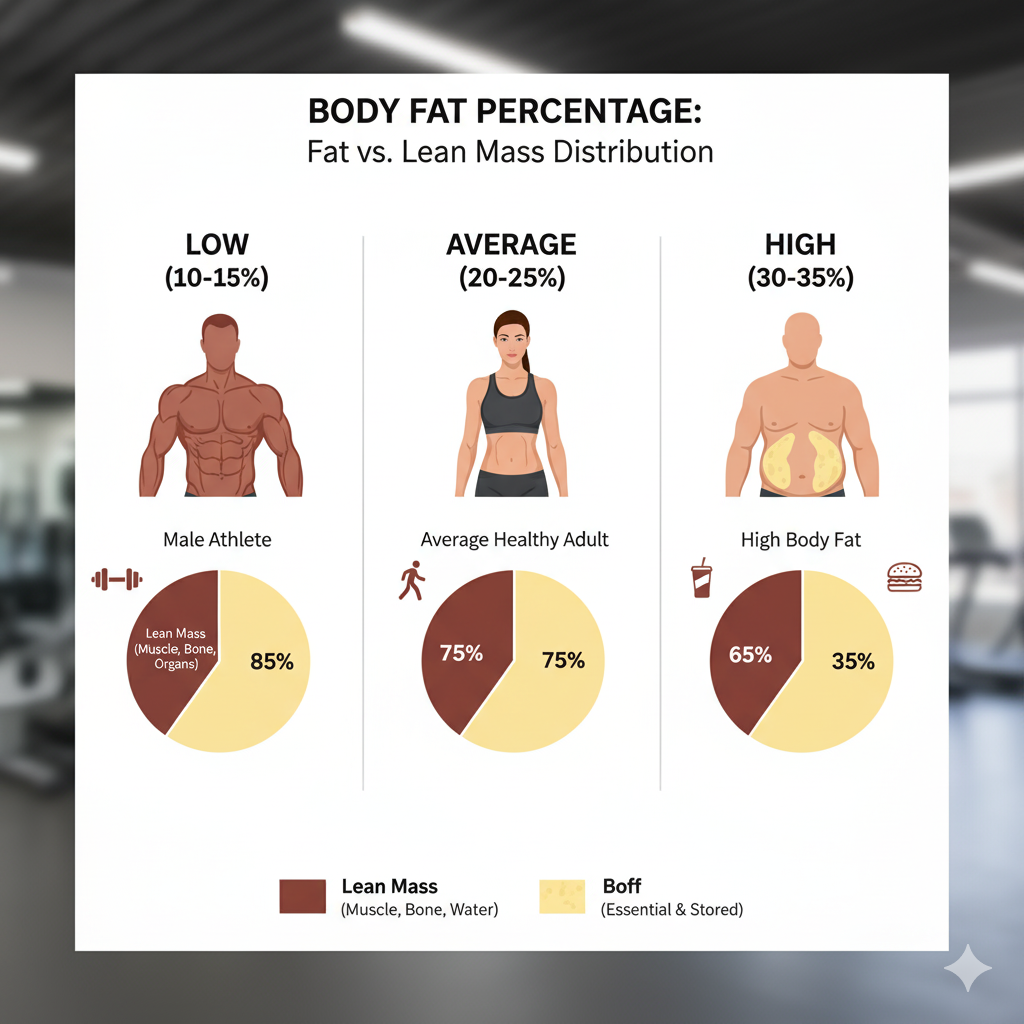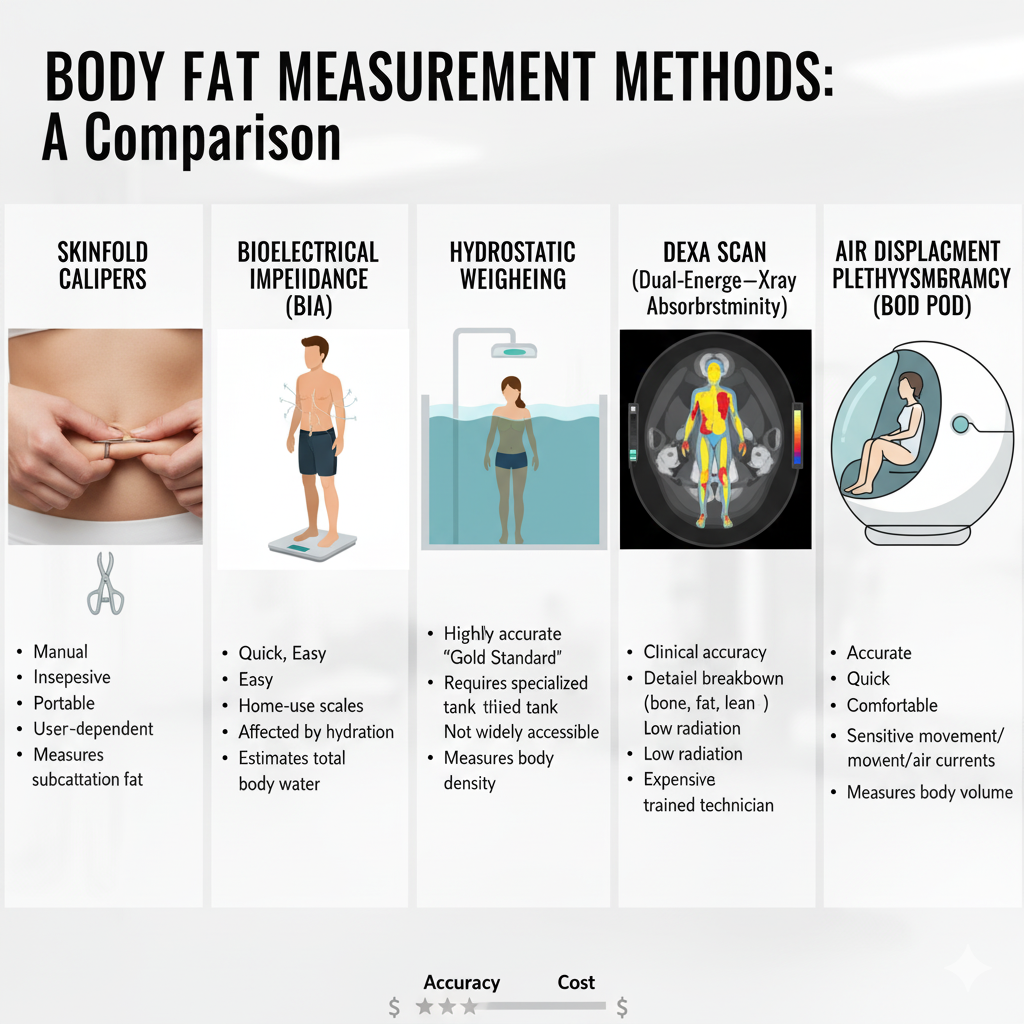Free Body Fat Calculator – Measure Your Fitness Accurately
Use our Body Fat Calculator to determine your body fat percentage quickly and accurately. This tool uses multiple scientifically validated formulas including the Navy Method, Army Standard, and YMCA formula to give you a reliable estimate of your body composition. Whether you are tracking weight loss, muscle gain, or overall fitness, knowing your body fat percentage is essential for setting and achieving your health goals.
Calculate Your Body Fat Percentage
Your Results
Health Assessment
Method Comparison Results
Navy Method
Most AccurateArmy Method
MilitaryYMCA Method
Age-AdjustedAnalysis & Recommendations
Navy Method
Correlation with DEXA: 85-90%. Best for general population.
Army Method
Military standard. Slightly conservative estimates.
YMCA Method
Age-adjusted. Good for older adults.
Body Fat Categories
Measurement Tips
- • Measure in the morning before eating
- • Keep the tape measure level and snug
- • Measure waist at the narrowest point
- • Measure neck just below the Adam's apple
- • For hips, measure at the widest point
Complete Guide to Body Fat Percentage
Everything you need to know about body fat measurement, health implications, and improvement strategies

People Also Ask About Body Fat
How do I calculate my body fat?
The most practical way to calculate body fat at home is using measurement-based methods like the Navy or Army formulas. Our Body Fat Calculator uses these proven methods - you'll just need a tape measure and about 5 minutes. For even more accuracy, consider professional methods like DEXA scans or BodPod testing.
Is 20% body fat realistic?
Absolutely! 20% body fat falls within the "fitness" range for men and is actually quite lean for women (falling in their "athletic" range). This percentage represents a healthy, sustainable level that many fitness enthusiasts maintain. It's enough to protect your health while still showing muscle definition.
What does 30% body fat look like?
At 30% body fat, most people have a noticeably rounded appearance with minimal muscle definition. For women, this is in the "average" range, while for men it's considered "obese." Clothing typically fits snugly, especially around the waist. But remember, body fat distribution varies - some people carry it more evenly while others store more in specific areas like the abdomen or thighs.
Is a BMI of 27 fat?
A BMI of 27 falls in the "overweight" category, but it doesn't necessarily mean you have excess body fat. BMI doesn't distinguish between muscle and fat, so athletic individuals with high muscle mass often have elevated BMIs without excess fat. That's why body fat percentage gives a clearer picture of your actual composition. Check your body fat using our calculator for a more accurate assessment.
Table of Contents
# Understanding Body Fat Percentage

Body fat percentage is a crucial health metric that represents the proportion of your total body weight that consists of fat tissue. Unlike simple weight measurements, body fat percentage provides insight into your body composition, distinguishing between fat mass and lean mass (muscles, bones, organs, and water). This measurement is essential for assessing overall health, fitness levels, and disease risk factors.
The human body requires a certain amount of fat to function properly. Essential fat is necessary for basic physical and physiological health, including protecting vital organs, regulating body temperature, storing vitamins, and producing hormones. However, excess body fat, particularly visceral fat around internal organs, can lead to serious health complications including cardiovascular disease, type 2 diabetes, and metabolic syndrome.
# Different Measurement Methods Explained

Different methods for measuring body fat percentage
Navy Method (Most Accurate)
The Navy method, developed by the U.S. Navy, is considered one of the most accurate body fat calculation methods available without expensive equipment. This method uses circumference measurements of specific body parts along with height to estimate body fat percentage. For men, it requires measurements of the neck and waist, while women need neck, waist, and hip measurements.
The Navy method's accuracy stems from its recognition that fat distribution patterns differ between genders and that certain body measurements correlate strongly with overall body fat. Research has shown this method to have a correlation coefficient of 0.85-0.90 with more expensive methods like DEXA scans, making it highly reliable for most individuals.
Army Method (Military Standard)
The Army method, used by the U.S. Army for fitness assessments, is similar to the Navy method but uses slightly different formulas and measurement points. This method has been refined over decades of military use and provides reliable results for determining whether service members meet body composition standards.
The Army method tends to be slightly more conservative in its estimates compared to the Navy method, which can be beneficial for fitness and health assessments. It's particularly useful for individuals with athletic builds, as it accounts for muscle mass distribution patterns common in physically active populations.
YMCA Method (Simplified Approach)
The YMCA method incorporates additional factors like age and weight along with circumference measurements. This method recognizes that body composition changes with age and that weight distribution affects body fat percentage calculations. While slightly more complex, it can provide more personalized results for certain age groups and body types.
# Health Implications of Body Fat Levels

Body fat percentage ranges and their health implications
Essential Fat (2-5% Men, 10-13% Women)
Essential fat represents the minimum amount of fat necessary for basic physical and physiological health. This fat is found in the heart, lungs, liver, spleen, kidneys, intestines, muscles, and lipid-rich tissues throughout the central nervous system. Women naturally have higher essential fat percentages due to reproductive functions and hormonal differences.
Having body fat below essential levels can lead to serious health complications including hormonal imbalances, compromised immune function, loss of reproductive function, and increased risk of injury. Athletes occasionally reach these levels temporarily during peak competition periods, but maintaining such low levels long-term is neither healthy nor sustainable.
Athletic Range (6-13% Men, 14-20% Women)
The athletic range represents body fat levels commonly seen in competitive athletes and highly trained individuals. People in this range typically have excellent cardiovascular health, high muscle mass, and optimal metabolic function. This level requires consistent training and careful nutrition management.
Athletes in sports requiring low body weight (distance running, gymnastics, wrestling) often maintain body fat in this range. However, it's important to note that achieving and maintaining these levels requires significant lifestyle commitments and may not be appropriate or necessary for general health and fitness.
Fitness Range (14-17% Men, 21-24% Women)
The fitness range represents an excellent level of body composition for general health and appearance. Individuals in this range typically have good muscle definition, healthy metabolic function, and reduced risk of chronic diseases. This level is achievable and maintainable for most people with consistent exercise and proper nutrition.
People in the fitness range often report high energy levels, good sleep quality, and positive body image. This range provides an excellent balance between health benefits and lifestyle sustainability, making it an ideal target for many fitness enthusiasts and health-conscious individuals.
Average Range (18-24% Men, 25-31% Women)
The average range represents typical body fat levels for the general population in developed countries. While not optimal, individuals in this range can still maintain good health with proper lifestyle choices. However, those at the higher end of this range may benefit from body composition improvements.
People in the average range should focus on maintaining their current level while working toward the fitness range through gradual lifestyle improvements. Small changes in diet and exercise can lead to significant health benefits and improved body composition over time.
Obese Range (25%+ Men, 32%+ Women)
Body fat levels in the obese range are associated with increased risk of numerous health conditions including cardiovascular disease, type 2 diabetes, sleep apnea, certain cancers, and metabolic syndrome. Individuals in this range should prioritize body composition improvement for health reasons and consider consulting healthcare professionals for guidance.
# Factors Affecting Body Fat Percentage
Genetics and Gender
Genetics play a significant role in determining body fat distribution patterns, metabolic rate, and the ease of gaining or losing fat. Some individuals are genetically predisposed to store fat in certain areas (apple vs. pear body shapes), while others may have naturally higher or lower metabolic rates.
Gender differences in body fat are primarily due to hormonal variations. Women typically have higher body fat percentages due to estrogen's effects on fat storage, particularly in preparation for pregnancy and breastfeeding. Men generally have lower body fat percentages and tend to store fat in the abdominal area, while women often store fat in the hips and thighs.
Age and Hormonal Changes
Body fat percentage typically increases with age due to several factors including decreased muscle mass (sarcopenia), reduced metabolic rate, hormonal changes, and often decreased physical activity. After age 30, adults typically lose 3-8% of muscle mass per decade, which can lead to increased body fat percentage even without weight gain.
Hormonal changes, particularly during menopause in women and andropause in men, can significantly affect body composition. Decreased testosterone in men and reduced estrogen in women can lead to increased fat storage and decreased muscle mass, making body composition management more challenging with age.
Diet and Nutrition
Nutrition plays the most significant role in body fat percentage, with the saying "abs are made in the kitchen" reflecting this reality. Caloric balance (calories consumed vs. calories burned) is the primary determinant of fat gain or loss, but macronutrient composition also affects body composition.
Protein intake is particularly important for maintaining muscle mass during fat loss, with recommendations of 0.8-1.2 grams per pound of body weight for active individuals. Adequate protein intake helps preserve lean mass, supports recovery from exercise, and has a higher thermic effect than carbohydrates or fats, meaning it burns more calories during digestion.
Exercise and Physical Activity
Both cardiovascular exercise and resistance training contribute to healthy body composition, but in different ways. Cardiovascular exercise burns calories during the activity and can help create the caloric deficit necessary for fat loss. High-intensity interval training (HIIT) has been shown to be particularly effective for fat loss while preserving muscle mass.
Resistance training is crucial for building and maintaining muscle mass, which increases metabolic rate and improves body composition. Muscle tissue burns more calories at rest than fat tissue, so increasing muscle mass can help with long-term body fat management. A combination of both cardiovascular and resistance training typically produces the best results for body composition improvement.
# Strategies for Improving Body Composition
Creating a Sustainable Caloric Deficit
Fat loss requires creating a caloric deficit, meaning you burn more calories than you consume. A moderate deficit of 300-500 calories per day typically results in 1-2 pounds of fat loss per week, which is considered safe and sustainable. Extreme deficits can lead to muscle loss, metabolic slowdown, and difficulty maintaining the diet long-term.
The most effective approach combines dietary changes with increased physical activity. This allows for a reasonable caloric deficit while maintaining adequate nutrition and energy levels. Tracking food intake and physical activity can help ensure you're maintaining an appropriate deficit without going to extremes.
Optimizing Macronutrient Distribution
While total calories matter most for fat loss, macronutrient distribution can affect body composition, satiety, and adherence to your nutrition plan. A balanced approach typically includes 25-35% of calories from protein, 25-35% from healthy fats, and the remainder from complex carbohydrates.
Higher protein intake (1.0-1.2g per pound of body weight) during fat loss helps preserve muscle mass and increases satiety. Healthy fats support hormone production and nutrient absorption, while complex carbohydrates provide energy for workouts and daily activities. Timing of macronutrients around workouts can also optimize body composition changes.
Progressive Resistance Training
Resistance training is essential for building and maintaining muscle mass during fat loss. Progressive overload – gradually increasing weight, reps, or training volume – ensures continued muscle development and metabolic benefits. Full-body workouts 2-3 times per week can be effective for beginners, while more advanced individuals may benefit from split routines.
Compound exercises like squats, deadlifts, bench press, and rows should form the foundation of any resistance training program as they work multiple muscle groups simultaneously and provide the greatest metabolic benefit. These exercises also improve functional strength and movement patterns used in daily activities.
Cardiovascular Exercise Strategy
Cardiovascular exercise supports fat loss by increasing caloric expenditure and improving cardiovascular health. A combination of moderate-intensity steady-state cardio and high-intensity interval training (HIIT) typically produces the best results. HIIT can be particularly time-efficient and effective for fat loss while preserving muscle mass.
The key is finding cardiovascular activities you enjoy and can maintain consistently. This might include walking, cycling, swimming, dancing, or sports activities. Consistency is more important than intensity – regular moderate exercise is better than sporadic intense sessions.
# Common Mistakes and How to Avoid Them
Focusing Only on Weight Loss
Many people focus exclusively on the number on the scale rather than body composition. Weight can fluctuate due to water retention, muscle gain, and other factors that don't reflect fat loss. It's possible to lose fat and gain muscle simultaneously, resulting in improved body composition without significant weight change.
Instead of relying solely on weight, use multiple metrics including body fat percentage, circumference measurements, progress photos, and how clothes fit. These provide a more complete picture of body composition changes and can help maintain motivation when the scale doesn't move as expected.
Extreme Caloric Restriction
Severely restricting calories may lead to rapid initial weight loss, but it often results in muscle loss, metabolic slowdown, and difficulty maintaining the diet long-term. Very low-calorie diets can also lead to nutrient deficiencies, fatigue, and increased risk of binge eating.
A moderate approach with a 300-500 calorie deficit is more sustainable and effective for long-term fat loss while preserving muscle mass. This allows for adequate nutrition, energy for workouts, and better adherence to the plan over time.
Neglecting Resistance Training
Many people, particularly women, avoid resistance training due to fears of "bulking up" or preferences for cardiovascular exercise. However, resistance training is crucial for maintaining muscle mass during fat loss and improving overall body composition.
Building significant muscle mass requires specific training, nutrition, and often genetic predisposition. For most people, resistance training will create a lean, toned appearance rather than excessive muscle bulk. The metabolic benefits of increased muscle mass also support long-term fat loss maintenance.
Inconsistent Measurement Techniques
Accurate body fat percentage calculations require consistent measurement techniques. Variations in measurement location, tape tension, time of day, and hydration status can all affect results. Always measure at the same time of day, preferably in the morning before eating, and use the same measurement points each time.
# When to Consult Healthcare Professionals
While body fat calculators provide useful estimates, certain situations warrant professional consultation. If your calculated body fat percentage is in the obese range, consider consulting a healthcare provider to assess overall health and develop an appropriate improvement plan.
Individuals with eating disorders, extreme body fat levels (very low or very high), or underlying health conditions should work with qualified professionals including physicians, registered dietitians, and certified fitness professionals. These experts can provide personalized guidance and monitor progress safely.
Additionally, if you're not seeing expected results despite consistent efforts, professional guidance can help identify potential issues with your approach and provide evidence-based solutions tailored to your specific situation and goals.
# Conclusion
Understanding and monitoring body fat percentage is a valuable tool for assessing health and fitness progress. While the calculation methods provided by our body fat calculator offer good estimates, remember that they are tools to guide your health journey, not definitive medical diagnoses.
The most important aspect of body composition management is developing sustainable lifestyle habits that support your long-term health and well-being. Focus on creating a balanced approach that includes proper nutrition, regular exercise, adequate sleep, and stress management. Remember that healthy body composition is achieved through consistency and patience, not quick fixes or extreme measures.
Calculate Your Body Fat Percentage
Use our accurate calculator to understand your body composition and set realistic goals
Calculate Body Fat PercentageExplore our other health tools: BMI Calculator • BMR Calculator • Calorie Calculator